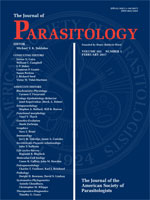The trematodes belonging to the genus Platynosomum are biliary parasites of birds and mammals (domestic and wildlife) in tropical and subtropical areas of the globe. Despite several reports on platynosomosis in captive nonhuman primates, mainly in South America, the taxonomy of species of Platynosomum that infect these hosts remains confused, and it is not clear whether the species found in cats is the same that infects nonhuman primates. Because a detailed morphological study of Platynosomum from nonhuman primates is lacking, in this study we analyzed specimens of Platynosomum recovered from the biliary system of Callithrix penicillata kept in captivity in an animal facility. The helminths were submitted to morphological and morphometric analyses in a light microscope and measurements of 16 morphological traits were taken. A kernel density estimation (KDE) was used to estimate density distributions of the measurements obtained as well as the occurrence of overlap with the ranges of the measurements known to 2 other species of Platynosomum previously described from South American marmosets, Platynosomum amazonensis and Platynosomum marmoseti. A principal component analysis (PCA) was also performed in order to evaluate the position of each of the 3 species in the multivariate gradient of morphometric measurements. The occurrence of a growth gradient was also evaluated by analysis of correlation between the measurements. Besides a great morphological variability, all specimens obtained from marmosets in this study were identified as Platynosomum illiciens (Braun, 1901). In addition, the published ranges of the measurements of P. amazonensis and P. marmoseti were completely contained within the ranges found in this study as revealed by KDE. The PCA did not show the formation of groups, and the 3 species were distributed along a growth continuum, also corroborated by correlation analysis. Therefore, P. amazonensis and P. marmoseti are here synonymized with P. illiciens. The involvement of wildlife hosts to the epidemiology of feline platynosomosis and implications for its control are briefly discussed.
How to translate text using browser tools
1 February 2017
Platynosomum illiciens (Trematoda: Dicrocoeliidae) in Captive Black-Tufted Marmoset Callithrix penicillata (Primates: Cebidae) from Brazil: A Morphometric Analyses with Taxonomic Comments on Species of Platynosomum from Nonhuman Primates
Hudson A. Pinto,
Vitor L. T. Mati,
Diego G. F. Pujoni,
Alan L. Melo
ACCESS THE FULL ARTICLE

Journal of Parasitology
Vol. 103 • No. 1
February 2017
Vol. 103 • No. 1
February 2017




